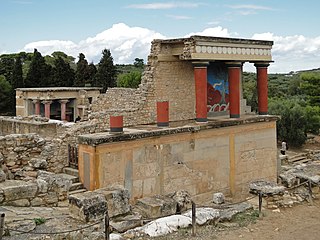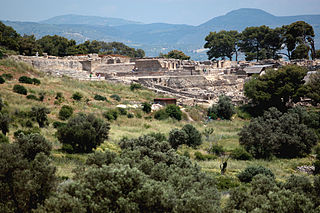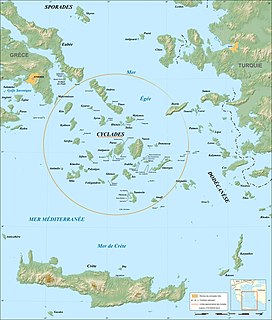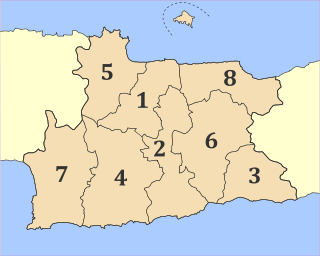
The Minoan civilization was a Bronze Age Aegean civilization on the island of Crete and other Aegean Islands, whose earliest beginnings were from c. 3500 BC, with the complex urban civilization beginning around 2000 BC, and then declining from c. 1450 BC until it ended around 1100 BC, during the early Greek Dark Ages. It represents the first advanced civilization in Europe, leaving behind a number of massive building complexes, sophisticated art, and writing systems. Its economy benefited from a network of trade around much of the Mediterranean.

Knossos is the largest Bronze Age archaeological site on Crete and has been called Europe's oldest city.

The history of Crete goes back to the 7th millennium BC, preceding the ancient Minoan civilization by more than four millennia. The palace-based Minoan civilization was the first civilization in Europe.

Phaistos, also transliterated as Phaestos, Festos and Latin Phaestus, is a Bronze Age archaeological site at modern Faistos, a municipality in south central Crete. Ancient Phaistos was located about 5.6 km (3.5 mi) east of the Mediterranean Sea and 62 km (39 mi) south of Heraklion, the second largest city of Minoan Crete. The name Phaistos survives from ancient Greek references to a city in Crete of that name at or near the current ruins.

Cycladic culture was a Bronze Age culture found throughout the islands of the Cyclades in the Aegean Sea. In chronological terms, it is a relative dating system for artifacts which broadly complement Helladic chronology and Minoan chronology (Crete) during the same period of time.

Franchthi Cave or Frankhthi Cave is an archaeological site overlooking Kiladha Bay, in the Argolic Gulf, opposite the village of Kiladha in southeastern Argolis, Greece.

Heraklion is one of the four regional units of Crete. The capital is the city of Heraklion.

Pseira is an islet in the Gulf of Mirabello in northeastern Crete with the archaeological remains of Minoan and Mycenean civilisation.

Minoan pottery has been used as a tool for dating the mute Minoan civilization. Its restless sequence of quirky maturing artistic styles reveals something of Minoan patrons' pleasure in novelty while they assist archaeologists in assigning relative dates to the strata of their sites. Pots that contained oils and ointments, exported from 18th century BC Crete, have been found at sites through the Aegean islands and mainland Greece, on Cyprus, along coastal Syria and in Egypt, showing the wide trading contacts of the Minoans.

Psychro Cave is an ancient Minoan sacred cave in Lasithi plateau in the Lasithi district of eastern Crete. Psychro is associated with the Diktaean Cave, one of the putative sites of the birth of Zeus. Other legends place Zeus' birthplace as the Idaean Cave on Mount Ida. According to Hesiod, Theogony, Rhea gave birth to Zeus in Lyctus and hid him in a cave of Mount Aegaeon. Since the late nineteenth century the cave above the modern village of Psychro has been identified with the Diktaean Cave, although there are other candidates, especially a cave above Palaikastro on Mount Petsofas.

Vasiliki is the name of a village in the municipality of Ierapetra, in the prefecture of Lasithi, on Crete, and the name of the nearby Minoan archeological site. The site took its name from the village.

Amnisos, also Amnissos and Amnisus, is a Bronze Age settlement on the north shore of Crete that was used as a port to the palace city of Knossos. It appears in Greek literature and mythology from the earliest times, but its origin is far earlier, in prehistory. The historic settlement belonged to a civilization now called Minoan. Excavations at Amnissos in 1932 uncovered a villa that included the "House of the Lilies", which was named for the lily theme that was depicted in a wall fresco.

The Heraklion Archaeological Museum is a museum located in Heraklion on Crete. It is one of the greatest museums in Greece and the best in the world for Minoan art, as it contains by far the most important and complete collection of artefacts of the Minoan civilization of Crete. It is normally referred to scholarship in English as "AMH", a form still sometimes used by the museum in itself.

The Minoan chronology dating system is a measure of the phases of the Minoan civilization. Initially established as a relative dating system by English archaeologist Sir Arthur Evans between 1900 and 1903 based on his analysis of Minoan pottery during his excavations at Knossos on Crete, new technologies including carbon dating and DNA analysis have led to significant revisions to the date ranges.

Minoan religion was the religion of the Bronze Age Minoan civilization of Crete. In the absence of readable texts from most of the period, modern scholars have reconstructed it almost totally on the basis of archaeological evidence of such as Minoan paintings, statuettes, vessels for rituals and seals and rings. Minoan religion is considered to have been closely related to Near Eastern ancient religions, and its central deity is generally agreed to have been a goddess, although a number of deities are now generally thought to have been worshipped. Prominent Minoan sacred symbols include the bull and the horns of consecration, the labrys double-headed axe, and possibly the serpent.
Kephala is a hill landform in northern Crete, Greece. This location was chosen by ancient settlers for the site of the Palace of Knossos; the footprint of the Neolithic settlement at Kephala Hill was actually larger than the Bronze Age Palace of Knossos.
Magasa is a Neolithic settlement on the eastern part of the island of Crete in present-day Greece. Magasa is notable as a Neolithic Cretan settlement for some use of large room sizes in its multi-roomed residences. The ben-and-but style of housing design with some use of mud-dried brick has been noted as similar to that found in Neolithic Knossos.

Kastelli Hill is a landform at the city of Chania on the island of Crete in the present day country of Greece. The Minoan city of ancient Cydonia was centered on Kastelli Hill, which later was selected by the Romans as the site of an acropolis.

The Skotino cave is one of the largest and more impressive caves among the many caves found in Crete.

Mercy Seiradaki was a British archaeologist who worked in Crete in the 1930s, mostly on projects led by John Pendlebury, including excavations at Knossos. She co-authored several reports on the work undertaken with him and published a later key text on the pottery from Karphi in 1960. During the war she worked at Bletchley Park, and then joined the Red Cross. She worked with the United Nations Relief and Rehabilitation Administration (UNRRA) in Crete in the post-war years and lived in Greece for the rest of her life.


















